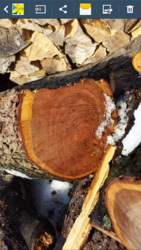Poindexter
Minister of Fire
As above, softwoods like spruce and pine are your best friends for September 2015.
If I could burn spruce only in my cat stove for the rest of my life I would have 1 complaint only, the bark flaking off on the living room carpet getting from the garage to the stove. The family dries quick and burns nice.
From reading about it here, once you have a good supply of evergreen split and stacked, go after ash, cherry and soft maple next. Once you have a bunch of that in the pipeline, then cut up your first oak tree and look for it to be ready in Sept 17 maybe if you get it up fast, or more likely Sep 2018 if you spend a fair amount of time on evergreen and cherry first.
If you have any birch its a candidate for Sep 2015. Whack it with a baseball bat or similar before you fell it. Look for conchs, fungus globs growing on the trunk. If you find one with zero, one or two conchs on it still alive and tinkling like a bowling pin when you whack the snot out of it, go ahead on, fell it and split it smaller than a 4x4 for Sep 2015 with good sun and good wind, stacked off the ground and covered on top. 21M BTU per cord average, pretty good really. Punky birch with center rot is good enough to burn in shoulders, but you got to cover birch punk, it will absorb a lot of water in a hurry otherwise.
If you find a birch that sounds at all dull when you whack it, or one with three or more conchs on it, leave it standing for bird habitat. If you got three birches to choose from, whack all three. Leave the dull sounding two, fell the tinkly sounding one and see what you got.
If I could burn spruce only in my cat stove for the rest of my life I would have 1 complaint only, the bark flaking off on the living room carpet getting from the garage to the stove. The family dries quick and burns nice.
From reading about it here, once you have a good supply of evergreen split and stacked, go after ash, cherry and soft maple next. Once you have a bunch of that in the pipeline, then cut up your first oak tree and look for it to be ready in Sept 17 maybe if you get it up fast, or more likely Sep 2018 if you spend a fair amount of time on evergreen and cherry first.
If you have any birch its a candidate for Sep 2015. Whack it with a baseball bat or similar before you fell it. Look for conchs, fungus globs growing on the trunk. If you find one with zero, one or two conchs on it still alive and tinkling like a bowling pin when you whack the snot out of it, go ahead on, fell it and split it smaller than a 4x4 for Sep 2015 with good sun and good wind, stacked off the ground and covered on top. 21M BTU per cord average, pretty good really. Punky birch with center rot is good enough to burn in shoulders, but you got to cover birch punk, it will absorb a lot of water in a hurry otherwise.
If you find a birch that sounds at all dull when you whack it, or one with three or more conchs on it, leave it standing for bird habitat. If you got three birches to choose from, whack all three. Leave the dull sounding two, fell the tinkly sounding one and see what you got.



